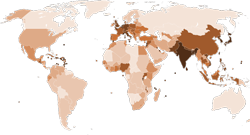Proximity to Cryptids

Population Map (Fg. 10-18)
Ocean systems worldwide are a great example of areas teeming with undiscovered life due to their vastness and a significant pressure barrier hindering exploration. Land surface area of Earth is roughly 57.3 million square miles averaging to around 122 people per square mile, however, the majority of human population is concentrated around coastal areas, rivers and lakes.
Nearly 68% of world population is lives within 250 miles of a coast, leaving plenty of habitable room for unknown creatures to thrive. As density increases, more and more people are migrating into forests and mountains for places to call home. This has an adverse environmental effect especially to species who depend on the forest canopies for cover, and it begins to flush animal populations, forcing them to adapt to new environments or perish.
Combining a quickly growing human population with need for space, advances in technology, and increased interest in outdoor recreation may indicate why legitimate sightings are on the rise over the past two centuries. Perhaps the hiding locations these animals frequent are no longer sufficient for survival due to increased human activity - Essentially forcing migration to more barren terrains, or even underground into deep cavern systems. Field biologists know this sort of behavior is happening currently with known species as encounters with wild animals are on the rise as more humans move into animal territories.
† Article 10-18
